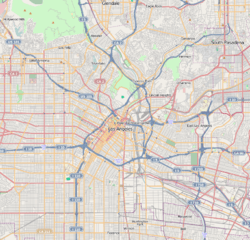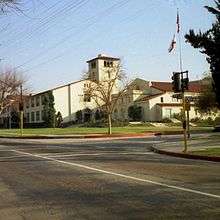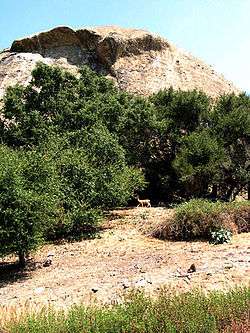Eagle Rock, Los Angeles
Coordinates: 34°08′20″N 118°12′47″W / 34.13889°N 118.21306°W
| Eagle Rock, California | |
|---|---|
| Neighborhood of Los Angeles | |
 Eagle Rock as delineated by the Los Angeles Times | |
 Eagle Rock, California Location within Central Los Angeles | |
| Coordinates: 34°08′20″N 118°12′47″W / 34.13889°N 118.21306°W | |
| Country |
|
| State |
|
| County |
|
| City |
|
| Government | |
| • U.S. House | Xavier Becerra (D) |
| Area[1] | |
| • Total | 11.0 km2 (4.25 sq mi) |
| Population (2008)[1] | |
| • Total | 34,644 |
| • Density | 3,100/km2 (8,200/sq mi) |
| The Eagle Rock | |
|---|---|
|
The Eagle Rock | |
| Location | Eagle Rock, Los Angeles, CA |
| Coordinates | 34°8′36″N 118°11′1″W / 34.14333°N 118.18361°W |
| Area | Northeast Los Angeles |
| Designated | November 16, 1962[2] |
| Reference no. | 10 |

Eagle Rock is a neighborhood of Northeast Los Angeles in the San Rafael Hills, Los Angeles County, California.
Eagle Rock is named after a large rock outcropping, resembling an eagle with its wings outstretched. The land was part of the Rancho San Rafael under Spanish and Mexican governorship. It was divided into parcels in 1870. It became a city in 1911 and joined Los Angeles in 1923.
Today it is an ethnically diverse, relatively high-income neighborhood known for being the home of Occidental College and for a counterculture element among its 34,000+ people. Eagle Rock maintains a number of historically significant buildings and has a connection with the motion picture industry.
There are nine public schools—including two high schools—and six private schools, as well as a branch public library.
Nomenclature
A massive boulder at the district's northern edge contains an indentation which casts a bird-shaped shadow on the rock at certain times of day, giving the neighborhood its name.[3]
History
Before the arrival of European settlers, the secluded valley below the San Rafael Hills that is roughly congruent to Eagle Rock's present boundaries was inhabited by the Tongva people, whose staple food was the acorns from the valley's many oak trees.[3][4] These aboriginal inhabitants were displaced by Spanish settlers in the late 18th century, with the area incorporated into the Rancho San Rafael.[4] Following court battles, the area known as Rancho San Rafael was divided into 31 parcels in 1870. Benjamin Dreyfus was awarded what is now called Eagle Rock.[4] In the 1880s Eagle Rock existed as a farming community.
The arrival of American settlers and the growth of Los Angeles resulted in steadily increasing semi-rural development in the region throughout the late 19th century. The construction of Henry Huntington's Los Angeles Railway trolley line up Eagle Rock Blvd. to Colorado Blvd. and on Colorado to Townsend Ave. commenced the rapid suburbanization of the Eagle Rock Valley. Eagle Rock was incorporated as an independent city in 1911.[3][4][5] The depletion of the young city's wells, and their incipient contamination due to the lack of a sewer system, led the citizens of Eagle Rock to agree to amalgamation with the city of Los Angeles in 1923.[5]
Several of the major crime sprees that have become part of Los Angeles' late 20th century history have left their mark on the neighborhood. An early victim of the Hillside Strangler was discovered in an Eagle Rock neighborhood on October 31, 1977. The discovery, along with the successive murders of at least 10 other women in the area over the course of the five months, rocked what was then a small, close-knit community on the outskirts of Los Angeles. In an opinion piece to the Los Angeles Times on December 6, 1977, a resident under the pseudonym Deirdre Blackstone wrote of the fear experienced by the community: "Groups of gum-chewing girls in look-alike hairdos and jeans who used to haunt the Eagle Rock Plaza — they too are keeping close to home ... We are all afraid. For women living alone, ours is an actual visceral fear that starts at the feet. Then it hits the knees — and finally it grips the mind." Two men, Kenneth Bianchi and Angelo Buono, were subsequently convicted of the murders. On the night of March 20, 1985, an 8-year-old girl was abducted from her home in Eagle Rock and sexually assaulted by a man dubbed the "Valley Intruder", "Walk-in Killer" and "The Night Stalker", later identified as Richard Ramirez. This was the seventh in a long string of murders and sexual assaults committed by Ramirez in Los Angeles and San Francisco before he was apprehended.[6]
Population
The neighborhood is inhabited by a wide variety of ethnic and socioeconomic groups and the creative class.[3][4] Over the past decade the Eagle Rock and neighboring Highland Park have been experiencing gentrification as young urban professionals have moved from nearby neighborhoods such as Los Feliz and Silver Lake.[4] A core of counter-culture writers, artists and filmmakers has existed in Eagle Rock since the 1920s.[4]
According to the "Mapping L.A." project of the Los Angeles Times, the 2000 U.S. census counted 32,493 residents in the 4.25-square-mile Eagle Rock neighborhood—or 7,644 people per square mile, an average population densities for both the city and the county. In 2008, the city estimated that the population had increased to 34,466. In 2000 the median age for residents was 35, about average for city and county neighborhoods.[1]
The neighborhood was considered "highly diverse" ethnically within Los Angeles, with a relatively high percentage of Asian people. The breakdown was Latinos, 40.3%; whites, 29.8%; Asians, 23.9%; blacks, 1.8%; and others, 4.1%. The Philippines (35.1%) and Mexico (25.1%) were the most common places of birth for the 38.5% of the residents who were born abroad—an average figure for Los Angeles.[1]
The median yearly household income in 2008 dollars was $67,253, considered high for the city. The neighborhood's income levels, like its ethnic composition, can still be marked by notable diversity, but typically ranges from lower-middle to upper-middle class.[7] Renters occupied 43.9% of the housing stock, and house- or apartment-owners held 56.1%. The average household size of 2.8 people was considered normal for Los Angeles.[1]
Geography
Eagle Rock is bordered by the city of Glendale on the north and west, Highland Park on the southeast, Glassell Park on the southwest and the cities of Pasadena and South Pasadena on the east. Major thoroughfares include Eagle Rock Boulevard and Colorado Boulevard, with Figueroa Street along the eastern boundary. The Glendale and Ventura freeways run along the district's western and northern edges, respectively.
Notable sights
Hill Avenue, now Hill Drive, was (and still is) one of Eagle Rock's most beautiful streets. Other streets were Royal Drive (now Mt. Royal Drive), Acacia Street (now Laverna Avenue), Kenilworth Avenue (now Hermosa Avenue), Highland Avenue (now Highland View Avenue), and Fairmont Avenue (now Maywood Avenue).[4] In the 1950s, newer streets such as Kincheloe Drive were extended into the hillsides for the building of larger homes with a view of the city. Today these streets are dotted with large and expensive homes on wide lots.
The neighborhood is home to many historic and architecturally significant homes, many done in the Craftsman,[3] Georgian, Streamline Moderne,[4] Art Deco and Mission Revival styles.[3]
Eagle Rock, once a separate municipality, still has its original City Hall (Historic and Cultural Monument #59, 2035 Colorado Blvd.).[8] Its original library, which was built with the aid of a Carnegie grant in 1914, was replaced in 1927 with a new structure which used one wall and the basement of the old library. This building (2225 Colorado Blvd.) has been listed on the National Register of Historic Places and converted into the Center for the Arts, Eagle Rock, previously the Eagle Rock Community Cultural Center.[5]
Motion picture industry

With such a close proximity to Hollywood and the major motion picture studios, this community has often been a favored choice as a film location. Cameos include Top Gun, The Hunt for Red October, and a second-season episode of The O.C. Star Trek III was partially filmed on the campus of Occidental College. This campus also served as "California University" in the 1990s television series Beverly Hills, 90210. Quentin Tarantino filmed parts of Reservoir Dogs here and in neighboring Highland Park. Other movies filmed almost entirely in Eagle Rock include; all of the exterior scenes of The Incredible Shrinking Woman[9] (1981) starring Lily Tomlin, Record City[10] (1978) with Ed Begley, Jr. was filmed in its entirety in a defunct auto paint shop, and The Unwed Father[11] (1974) starring Joseph Bottoms had all of its exterior location shots filmed on the Eagle Rock High School campus.[12] Avril Lavigne's music video "Complicated" was mostly shot in the Eagle Rock Mall as well as some scenes from the popular television series Glee. Pharrell's music video "Happy" features several scenes shot in Eagle Rock, with locations including the CVS Pharmacy on Eagle Rock Blvd., Eagle Rock High School and the All-Star Lanes.[13] One scene from 500 Days of Summer was also shot in one of the streets intersecting Hill Drive.
Some of the architecture of Eagle Rock has been featured as well; the 5200 block of Shearin Avenue is frequently used, including during the 1984 filming of Teen Wolf, starring Michael J. Fox, and a house on the 4900 block of College View Avenue was used during the 1975 filming of The Day of the Locust, starring Donald Sutherland.
Ben Affleck, a former Occidental College student, lived on Hill Drive with then-roommate and co-writer Matt Damon while they wrote the script for Good Will Hunting, which would go on to win them a Best Original Screenplay Academy Award.[14]
Tom Cruise's character in Days of Thunder, Cole Trickle, is written as being from Eagle Rock.
Government and infrastructure
The United States Postal Service Eagle Rock Post Office is located at 7435 North Figueroa Street.[15]
The Eagle Rock Neighborhood Council (ERNC)[16] meets the first Tuesday of every month at 7 p.m. at Eagle Rock City Hall.[17]
Education
Thirty percent of Eagle Rock residents aged 25 and older had earned a four-year degree by 2000, an average percentage for the city.[1]

.jpg)

Colleges and universities
Eagle Rock is the site of Occidental College, which was first established in Boyle Heights in 1887, but a fire destroyed its original site in 1896; from there the college moved to a temporary location in Downtown Los Angeles until 1898 when it moved to Highland Park, and then to Eagle Rock in 1914. The campus was designed by architect Myron Hunt.[18][19]
Schools
Precollegiate schools within the Eagle Rock boundaries are:[20]
Public
Eagle Rock children attend schools in District 4[21] of the Los Angeles Unified School District.
- Eagle Rock High School, 1750 Yosemite Drive. Eagle Rock High School was built in 1927 by the City of Los Angeles, as promised at the time of Eagle Rock's annexation. The building was demolished in 1970 over concerns about its earthquake safety. It was replaced by a contemporary brutalist style building at the rear of the same school site.[5]
- Renaissance Arts Academy, charter high school, 1800 Colorado Boulevard
- Dahlia Heights Elementary School, 5063 Floristan Avenue
- Santa Rosa Charter Academy, middle school, 3838 Eagle Rock Boulevard
- Eagle Rock Elementary School, 2057 Fair Park Avenue
- Rockdale Elementary School, 1303 Yosemite Drive
- Delevan Drive Elementary School, 4168 West Avenue 42
- Toland Way Elementary School, 4545 Toland Way
- Annandale Elementary School, 6125 Poppy Peak Drive
- Celerity Troika Charter School, 1495 Colorado Boulevard[22]
Private
- Westminster Academy, elementary
- St. Dominic Elementary School, 2005 Merton Avenue
- Fusion Academy and Learning Center, 825 Colorado Boulevard
- Grace Christian Academy, 1664 Yosemite Drive
- American Montessori Preschool and Elementary, 4475 Eagle Rock Boulevard
- Montessori Children's World, 4371 Eagle Rock Boulevard
Libraries
Los Angeles Public Library operates the Eagle Rock Branch Library at 5027 Caspar Avenue.[23]
Notable residents
- Maria Bamford (comedian)[24]
- Marlon Brando (actor)[25][26]
- Zack de la Rocha (musician)[27]
- Paul Ecke (botanicals)[25]
- M.F.K. Fisher (writer)[28]
- Carlos R. Moreno (jurist)[25]
- Hanson Puthuff (artist)[25]
- John Steinbeck (author)[29]
- Zasu Pitts (actress)[25]
- Mark Ryden (artist)[30]
- Robert Shaw (conductor)[25]
- Madeleine Stowe (actress)[31]
- Marshall Thompson (actor)[25]
- Dalton Trumbo (screenwriter, author)[25]
- Lindsay Wagner (actress)[32]
See also
- Los Angeles Historic-Cultural Monuments on the East and Northeast Side
- List of districts and neighborhoods in Los Angeles
References
- 1 2 3 4 5 6 "Eagle Rock," Mapping L.A., Los Angeles Times
- ↑ Los Angeles Department of City Planning (September 7, 2007), Historic - Cultural Monuments (HCM) Listing: City Declared Monuments (PDF), City of Los Angeles, retrieved 2008-05-29
- 1 2 3 4 5 6 Eagle Rock Neighborhood Council, History of. Retrieved June 24, 2010
- 1 2 3 4 5 6 7 8 9 Eagle Rock Historical Society Time Line. Retrieved June 24, 2010
- 1 2 3 4 Warren, Eric. Images of America Eagle Rock. Arcadia Publishing 2009
- ↑ http://articles.latimes.com/1985-09-01/news/mn-25732_1_night-stalker
- ↑ Mapping America," New York Times
- ↑ Bariscale, Floyd (August 27, 2007), Big Orange Landmarks: No. 59 - Eagle Rock City Hall, retrieved November 6, 2014
- ↑ Incredible Shrinking Woman (1981)
- ↑ Record City (1978)
- ↑ The Unwed Father (1974)
- ↑ Eagle Rock High School
- ↑ "Eagle Rock gets happy with Pharrell Williams | The Eastsider LA". www.theeastsiderla.com. Retrieved 2015-09-19.
- ↑ "Eagle Rock Valley Historical Society". Retrieved on February 23, 2009.
- ↑ Post Office Location - EAGLE ROCK. United States Postal Service. Retrieved on December 9, 2008.
- ↑ Eagle Rock Neighborhood Council Website. Retrieved on June 24, 2010.
- ↑ Eagle Rock Neighborhood Council Website. Retrieved on May 14, 2013.
- ↑ Occidental College; A long Tradition. Retrieved on June 24, 2010Archived June 9, 2012, at the Wayback Machine.
- ↑ Occidental College Timeline. Retrieved on June 24, 2010
- ↑ "Eagle Rock: Schools". Mapping L.A., Los Angeles Times
- ↑ "Eagle Rock Jr./Sr. High School". Retrieved 7 August 2011.
- ↑ School website
- ↑ "Eagle Rock Branch Library." Los Angeles Public Library. Retrieved on December 9, 2008.
- ↑ Deborah Vankin, "Maria Bamford Releases a Comedy Special Direct to Fans," Los Angeles Times, November 12, 2012
- 1 2 3 4 5 6 7 8 Eagle Rock Valley Historical Society
- ↑ "Once official production on The Men began, Brando moved out of the veterans hospital and into a small bungalow owned by his aunt, Betty Lindemeyer, in Eagle Rock, Calif." "Life With Marlon Brando: Early Photos," Life, undated
- ↑ Metro Boston News Sunday October 5th Archived September 26, 2008, at the Wayback Machine.
- ↑ O'Neill, Molly. "M.F.K. Fisher, Writer on the Art of Food and the Taste of Living, Is Dead at 83". The New York Times. Retrieved 1 November 2012.
- ↑ The Faster Master Plaster Caster
- ↑ "Ryden and Peck," Bizarre, June 2009.
- ↑ Los Angeles magazine
- ↑ Lindsay Wagner#Early life
External links
| Wikimedia Commons has media related to Eagle Rock, Los Angeles. |
- Eagle Rock Neighborhood Council
- Eagle Rock Valley Historical Society
- Eagle Rock crime map and statistics
 |
Glendale | Glendale | Pasadena |  |
| Glendale | |
Pasadena | ||
| ||||
| | ||||
| Silver Lake | Highland Park | Garvanza & South Pasadena |
